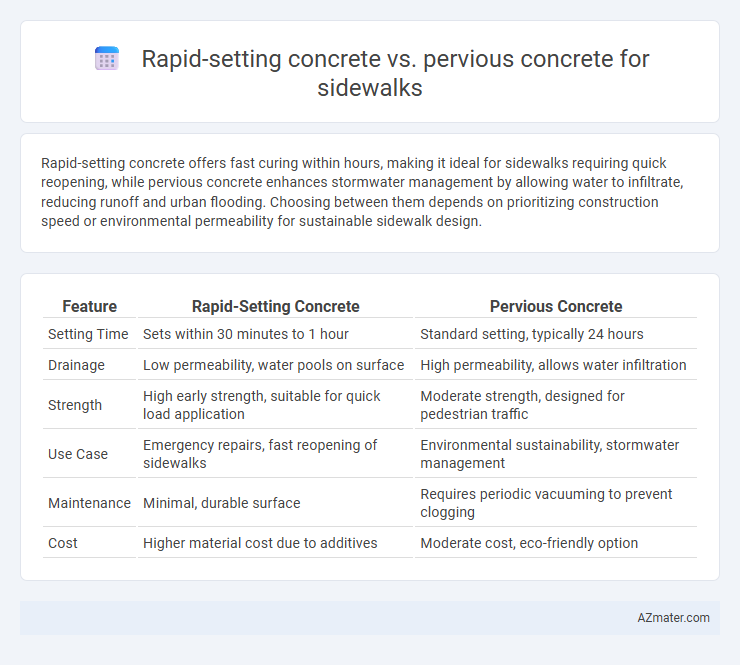Rapid-setting concrete offers fast curing within hours, making it ideal for sidewalks requiring quick reopening, while pervious concrete enhances stormwater management by allowing water to infiltrate, reducing runoff and urban flooding. Choosing between them depends on prioritizing construction speed or environmental permeability for sustainable sidewalk design.
Table of Comparison
| Feature | Rapid-Setting Concrete | Pervious Concrete |
|---|---|---|
| Setting Time | Sets within 30 minutes to 1 hour | Standard setting, typically 24 hours |
| Drainage | Low permeability, water pools on surface | High permeability, allows water infiltration |
| Strength | High early strength, suitable for quick load application | Moderate strength, designed for pedestrian traffic |
| Use Case | Emergency repairs, fast reopening of sidewalks | Environmental sustainability, stormwater management |
| Maintenance | Minimal, durable surface | Requires periodic vacuuming to prevent clogging |
| Cost | Higher material cost due to additives | Moderate cost, eco-friendly option |
Introduction to Rapid-setting and Pervious Concrete
Rapid-setting concrete cures quickly within a few hours, making it ideal for fast-paced sidewalk repairs and minimal disruption to pedestrian traffic. Pervious concrete features a high-porosity structure that allows water to infiltrate, reducing surface runoff and enhancing stormwater management in urban sidewalks. Both materials offer distinct advantages: rapid-setting concrete excels in durability and speed, while pervious concrete improves environmental sustainability through effective drainage.
Key Properties and Composition
Rapid-setting concrete for sidewalks features a high cement content and chemical accelerators that reduce curing time to as little as 30 minutes, enabling quick installation and early load-bearing capacity. Pervious concrete consists of a mixture of coarse aggregates, little to no fine aggregates, and a lower cement paste ratio, promoting high porosity for efficient stormwater drainage and environmental benefits. Key properties include rapid-setting concrete's high compressive strength and fast strength gain, whereas pervious concrete excels in permeability but has lower structural strength, making each suitable for different sidewalk performance requirements.
Installation Time and Construction Speed
Rapid-setting concrete dramatically reduces installation time for sidewalks, curing in as little as 1 to 3 hours, which allows for faster pedestrian access and minimal disruption. Pervious concrete, designed to improve drainage by allowing water infiltration, typically requires 24 to 48 hours to achieve sufficient strength for foot traffic, extending overall construction speed. Prioritizing rapid-setting concrete accelerates project timelines, whereas pervious concrete emphasizes environmental benefits at the cost of longer curing periods.
Durability and Longevity Comparison
Rapid-setting concrete offers high early strength and faster project completion, making it ideal for sidewalks requiring quick turnaround, but it may have reduced long-term durability under heavy freeze-thaw cycles compared to pervious concrete. Pervious concrete enhances water drainage and reduces hydrostatic pressure, significantly improving longevity by mitigating surface water damage and reducing freeze-thaw deterioration. When evaluating sidewalk materials, pervious concrete's superior durability in managing moisture and environmental stressors generally exceeds that of rapid-setting concrete, especially in climates prone to frequent precipitation.
Permeability and Drainage Capabilities
Rapid-setting concrete offers quick strength gain but has low permeability, making it less effective for drainage on sidewalks. Pervious concrete is engineered with high porosity, allowing water to infiltrate through the surface and enhancing stormwater management in urban areas. This superior permeability reduces runoff, mitigates flooding risks, and promotes groundwater recharge, making pervious concrete ideal for sustainable sidewalk applications.
Environmental Impact and Sustainability
Rapid-setting concrete minimizes construction time and reduces environmental disturbances by allowing quicker site restoration, but it typically involves higher energy consumption and CO2 emissions due to the use of more cementitious materials. Pervious concrete enhances sustainability by promoting groundwater recharge and reducing stormwater runoff, thereby mitigating urban heat island effects and improving local ecosystems. The choice between them depends on balancing the need for rapid installation with long-term environmental benefits in sidewalk projects.
Maintenance Requirements and Costs
Rapid-setting concrete offers lower maintenance needs due to its dense composition that resists cracking and surface wear, making it cost-effective over time for sidewalks subject to high foot traffic. Pervious concrete requires regular maintenance to prevent pore clogging and ensure proper water permeability, which can lead to higher long-term upkeep expenses despite its environmental benefits. Choosing between these materials depends on balancing initial costs, ongoing maintenance demands, and local drainage requirements for optimized sidewalk performance.
Typical Applications in Sidewalk Projects
Rapid-setting concrete is ideal for sidewalk projects requiring fast turnaround, such as emergency repairs and areas with high pedestrian traffic needing minimal downtime. Pervious concrete is commonly used in sidewalks designed for sustainable urban drainage, effectively managing stormwater and reducing runoff in environmentally sensitive locations. Both materials enhance sidewalk functionality but target different performance criteria--speed of use versus permeability.
Limitations and Challenges
Rapid-setting concrete for sidewalks offers quick curing times but faces limitations such as increased cracking risk and lower long-term durability under freeze-thaw cycles. Pervious concrete enhances stormwater management by allowing water infiltration but challenges include reduced compressive strength, clogging risks, and higher maintenance requirements. Both materials require careful mix design and site-specific considerations to balance functional performance and longevity in sidewalk applications.
Choosing the Right Concrete for Sidewalks
Rapid-setting concrete offers quick curing times, making it ideal for sidewalks requiring fast reopening to pedestrian traffic and minimizing downtime. Pervious concrete enhances stormwater management by allowing water to permeate through the surface, reducing runoff and supporting sustainable urban drainage systems. Selecting between rapid-setting and pervious concrete depends on project priorities such as construction speed, environmental impact, and local drainage needs.

Infographic: Rapid-setting concrete vs Pervious concrete for Sidewalk
 azmater.com
azmater.com